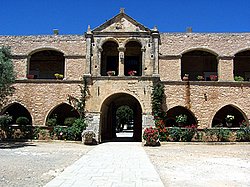Discover Retymno Rethymno, The Secret Capital of Crete
Rethymno is a port city in northern Crete. It is to Heraklion and Chania, the third largest city on the island and forms as the center of the homonymous municipality Regional District Rethymno. Apart from Heraklion Rethymno is one of the two sites of the University of Crete. There is a public hospital and a private hospital.
Rethymno lies between the other two major cities of Crete. The urban area of Rethymno extends in an east-west orientation 5.5 km along the north coast. The center and the historic core of the city are situated on a rocky peninsula east of this location bay allowed the installation of a port.
From the coast to the closed buildings only up to 1.5 km ranges near the city center to the south. The municipality, however, extends to 13 kilometers into the interior of the island. From the southernmost point of the borough close to the 1,310 meter high mountain Krioneritis the south coast of Crete at Koraka beach at Rodakino there are still about five kilometers.
The beautiful old town of Rethymno with its numerous attractions, quaint shops, traditional tavernas and cafes, offering a variety of quiet village life. The 20 km long sandy beach with good infrastructure, numerous water sports are available. You'll also find well-run dive centers.
The picturesque Prines
The small picturesque village Prines with its romantic narrow streets is located just 5 km above Rethymnon, the capital of the prefecture. Chania is some 65 km away, Heraklion about 80 km.
Anyone looking for a quiet and typical Greek resort, is right here. There are some holiday homes and apartments but hardly any hotels. There are several tavernas and shops available in the next place, Atsipopoulo, there is more of it. The shops have opened in the season usually until about 22.00 clock or clock 23.00. The proximity to Rethymnon and its long beaches make Prines so attractive.
The palm beach of Preveli
The palm beach of Preveli is lined with date palms sand beach on the south coast of Crete. It is close to the monastery Moni Preveli, whose name is passed to him.
Behind the beach forms the Megalopotamos, an incoming from the Kouroupa Mountains mountain stream, the small pond - or Lake of Preveli, which pulls up in the ravine behind it. The Cretan Date Palm (Phoenix theophrasti) here forms a natural palm grove.
From 21 22 August 2010, there was a large forest fire in the ravine behind the beach, where the Palmemhain burned to a large extent. On 1 April 2011 the Greek Ministry of Environment announced that the palm trees have almost completely recovered and all the palm trees were knocked out.
The palm beach of Preveli is located just a few kilometers from Plakias, Lefkogeia away. In Lefkogeia Villa Zeus, Helios Villa, Villa Apollon and Villa Asteri are highly recommended.
The Myli gorge
The Myli gorge (often described in the travel guides under canyon of the mills or Miihlenweg) is running from south to north canyon in the north of Crete. It is located southeast of Rethymnonund had numerous mills in Crete since the time of Venetian rule. Their remains are today a document pre-industrial agricultural work processes. In the gorge there are numerous, some rare plants and animals.
The gorge is located about 4 kilometers south-east of Rethymno and is about 4 km long. Significant places are Chromonastiri and Myli. Building the gorge is by a footpath along the mill stream, which rises on the northern slope of the 811 meter high mountain Angali. At the top starting point is a tavern.
In the canyon the remains of numerous complex built buildings, bridges and canals for water mills can be seen, that were in operation in the 16th century during the reign verezianischen in Crete, developed and partially into the 1970s. There were mainly flour mills processed the crops in the area of wheat. In the 1960s, the population left the old village of Kato Myli to move to new traffic favorable location (Neo Myli). The gorge is still a small tip for short hikes. (About 1 1/2 hours one way)
The Monastery of Arkadi
Almost a kind of sanctuary or shrine. For the Cretans the main structure of the island - a constant reminder and a reminder of the terrible time of the Turkish occupation and the heroism of the ancestors.
In the externally inconspicuous monastery one of the most horrible tragedies of the Cretan / Greek freedom struggle took place. On November 9, 1866 celebrated here, hundreds of men, women and children suicide together, so as not to drop the invading Turkish troops in their hands. Although the news of the terrible event roused the people around the world, it took over 30 years to the island was finally freed with the help of the Great Powers from the Turkish yoke.
Arkadi Monastery is the symbol of the absolute freedom of the Cretans. The visit is not worth out because of some spectacular sights, but only for this consciousness.












